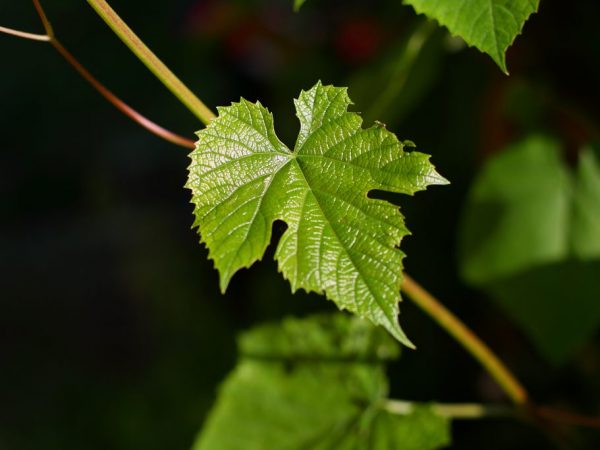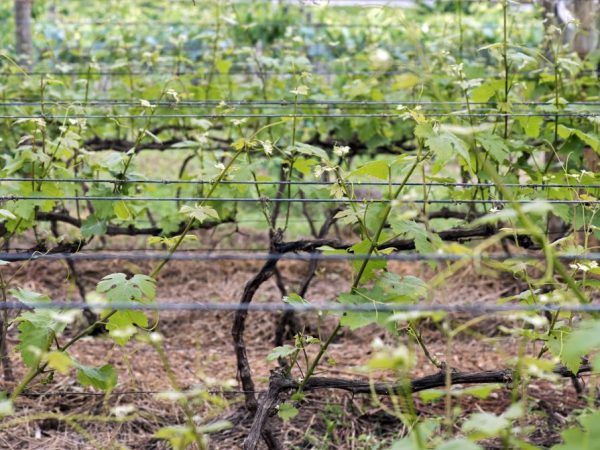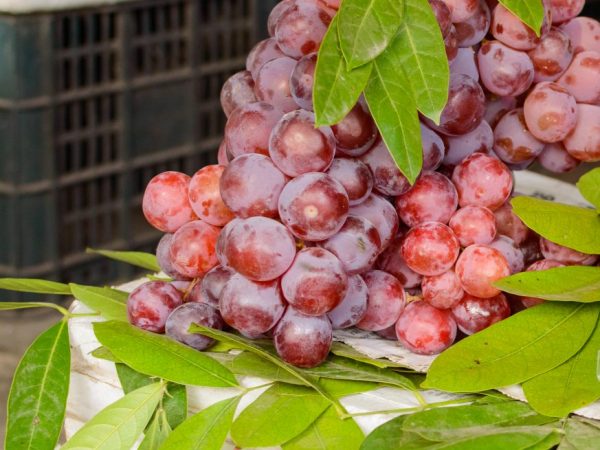How to feed grapes in spring
Correct and regular feeding of grapes helps to grow healthy, strong bushes, as well as get a good and high-quality harvest of berries. In the article we will consider how grapes are fed in the spring, with what preparations and in what time frame.

Top dressing of grapes in spring
Types of dressings
Basic care and cultivation of this crop requires a balanced diet. When planting, young seedlings do not require replenishment. Only in the second year of life they begin to feed them.
You can feed the grapes in spring with different fertilizers:
- organic;
- mineral.
Let us consider in detail all the drugs that make up their composition and what effect they have.
Organic
You can fertilize grapes in spring with organic fertilizers, which are quite convenient and profitable to work with. Moreover, almost every gardener has natural ingredients for their preparation at hand.
Manure
This is a versatile fertilizer. The manure contains all the necessary trace elements for the development, growth and fruiting of bushes - nitrogen, phosphorus, potassium. They can not only fertilize, but also enrich the land plot for planting seedlings. There are two ways to feed grapes in spring.
The first option is to lay humus in the soil. In the aisles, the top layer of soil is removed, then a layer of manure is laid and garden soil is placed on top of it. Such fertilization of grapes with spring feeding will last for three years.
If you plan to feed the bushes by watering, the following solution is prepared: 1 bucket of manure is consumed for 3 buckets of water. watered in the following proportion: 1 liter of substance per 10 liters of water. With a fortified composition, the plants spill holes dug along the diameter of the bush.
Compost
It will take about 8 months to get the nutrient fertilizer. During this time, food, wood and grass residues can rot and turn into a real storehouse of vitamins and minerals for planting.
For cooking, you will need several components: compost, rotted manure, water and lime. On the site, you need to allocate space for the tab of all components. Many people use wooden boxes for this. At the bottom of the container, compost is laid in a 20-centimeter layer, on top of it is a layer of manure, then a thin layer of lime goes and all this is poured with water. Such a layer must be made to the very top, or until all the components run out. The top of such a heap should be sprinkled with peat or garden soil. The next year, in early spring, the area with the plantings is sprinkled with compost.
Bird droppings
Chicken droppings promote good maturation of the vines. It contains all the essential nutrients for the bushes. Before use, poultry droppings are dissolved in water in a 1: 1 ratio. Then let it wander for 2 weeks. The resulting slurry is again diluted with water in a ratio of 1: 5. Only then can the bushes be fertilized with chicken droppings.Top dressing is applied at a distance of half a meter from the plant stem, so as not to burn the root.
Grass
You can feed grapes in spring with lupines, peas, vetch and other annual crops. Plants are scattered over the site, then the soil is dug up. They enrich the soil with oxygen and nutrients.
Mineral

We feed until the buds appear
For feeding grapes in spring, gardeners also use minerals.
They should be used with extreme caution and dosage. Since industrial chemistry can cause great harm to plants - it inhibits their growth or even provokes death. For the regions of the middle lane, it is recommended to feed the plants four times during the entire growing season, in the southern regions, three additional dressings are enough.
First feeding
The first spring feeding of grapes is carried out even before the beginning of the growing season - until the buds open. This procedure usually falls in April-May.
For this period, the following composition is used:
- phosphate fertilizers - 50 g;
- potash - 35 g;
- nitrogenous - 45 g.
A dry mixture of fertilizer for grapes is made in early spring and is applied to the holes dug around the bush at a half-meter distance from the trunk. This will provide the plant root with the maximum amount of nutrients. After that, top dressing is added with earth.
Also, the first feeding of grapes in the spring before the opening of the buds can be carried out with the preparation Solution. First, it is diluted in a ratio of 1:20 liters. Pull out the holes, pour them abundantly with water, then pour in the nutrient solution, and again water.
Second feeding
The second spring dressing for grapes is carried out a few days before the seedlings or mature bushes bloom - in summer or at the end of May, depending on the region where the bushes are grown.
Fertilizer consists of organic and mineral components. A ready-made solution of mullein or bird droppings is used as a natural fertilizer. Mineral fertilizers consist of the following components:
- potash - 30 g;
- phosphate - 50 g;
- nitrogenous - 40 g.
All components are mixed and dissolved in a bucket of water.
Organic and mineral components can be used together, provided that the dose of the latter is halved.
Third feeding
It is carried out during the period of mass appearance of pea-sized berries.
Complex fertilizers are used. 30 g of the drug is consumed per bucket of water. Such nutrition is necessary to increase the yield. If the dosage is observed and the complex feeding is correctly applied, the yield will double.
Fourth feeding
To feed the bushes at the initial stage of berry ripening, two components are used - phosphorus and potassium. For those who prefer natural feeding, potash fertilizers can be replaced with wood ash obtained from burnt branches of fruit trees or the same grapes.
Foliar nutrition

Good harvest when grown properly
Almost always in early spring, foliar feeding of grapes is combined with root. This procedure includes basic care and proper crop cultivation. Foliar nutrition gives an effective result just a few days after it is carried out. Nutrients are absorbed fairly well and quickly by plant leaves. Compared with fertilizers that are applied under the root, the concentration of foliar is significantly reduced.
Fertilization for grapes in early spring is carried out several times:
The first spring leaf treatment is carried out 4-5 days before the beginning of flowering. At this stage, the plants need to be treated with a boric acid solution. 5 g of the substance is diluted in 10 l of water. This amount of top dressing is used to irrigate one bush. In combination with this solution, fungicides are used to destroy pathogenic microflora.To build up young foliage, the bushes are treated with nitroammophos.
The second spring leaf treatment is carried out 10 days after the flowering of the bushes. What fertilizer for grapes in the spring is best suited in this case? At this stage of growth, a complex of preparations is used - mineral (phosphorus) and organic (irrigation of leaves with wood ash is allowed).
The third time, the nutrition of the leaves is applied 2 weeks after the introduction of the second. Plants are re-irrigated with wood ash and superphosphate.
The last foliar dressing of grapes in spring is carried out 2 weeks before the end of the ripening of the crop and its harvest. The bushes are irrigated with phosphate-potassium preparations to prepare them for the upcoming wintering.
It is recommended to carry out such a procedure in the morning or evening hours, and in calm weather. It is necessary to spray the underside of the foliage.
Urea
Urea (second name is urea). Among all spring fertilizers for grapes from liquid dressings, urea takes pride of place. It is applied to young plants 2-3 years after planting in the ground.
Root way
The solution is prepared as follows: 30 g of the substance is dissolved in 10 water.
Fertilizing of young and adult vineyards with urea is carried out both by root and foliar methods. Complex nutrition improves the absorption of all nutrients by the bushes.
Processing scheme:
The initial feeding begins in the first or second decade of March, when the shelter is removed from the bushes. For this purpose, the following composition is used: potash, phosphate fertilizers and urea - 40 g of each substance. After watering has been carried out, the plants are again covered with a covering material.
The second plant feeding takes place in May. During this period, mass budding and the development of young foliage begin. Urea fertilization is applied two weeks before the flowering of the vines. The composition is the same as in the first case. After that, the plants are plentifully watered so that the roots can nourish vitamins and minerals.
The third feeding is carried out without the use of urea - only phosphorus and potassium.
Foliar method
For foliar feeding of grapes in the spring, 1% urea solution is used. Plants are sprayed early in the morning or in the evening. A prerequisite for successful processing is dry and calm weather.
The action of the constituents
Impact on the plant of mineral and organic fertilizers:
- Phosphorus fully stimulates the development of ovaries and berries, improves the quality of the harvest.
- Nitrogen stimulates the intensive growth of green mass - shoots, leaves.
- Potassium is necessary for plants during the ripening period of berries. In addition, this element helps the bushes prepare for wintering and get stronger after harvest.
- Zinc is used as a crop stimulant.
- Boric acid increases the juiciness and sweetness of the berries.
- Copper provides powerful protection to bushes during wintering, drought.
Conclusion
Now you know how and what to feed grapes in the spring. This procedure helps the bushes to fully develop and bear fruit. Fertilization rules are suitable not only for experienced, but also for novice winegrowers.

